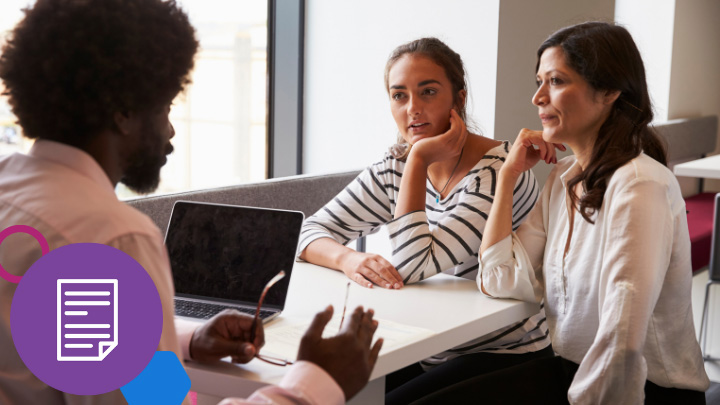In one of my first professional development (PD) sessions as a teacher, I learned about student discussion protocols. When I was a student, my classes were often disempowering and teacher-heavy, and because I didn’t want to recreate that dynamic as a new teacher, I was energized by learning strategies to get my students talking and engaged. As the session went on, I hurriedly scribbled ideas into my notebook. Soon, this notebook was packed with examples of discussion strategies and adorned with highlights and exclamation marks and underlined phrases, all signaling my genuine enthusiasm.
As the school year started, and my days became busy with teaching and planning and grading, my notebook was soon relegated to a drawer in my desk. The excitement of implementing discussion protocols was drowned out by the exhaustion of simply keeping up, and I fell almost exclusively into the practice I wanted to avoid: teacher-led discussions.
As a result of the common one-and-done approach to professional development, there was no follow-up on discussion protocols, and I didn’t have support to implement my learnings. This was a disservice to me and my students. I became burnt out by the burden of planning teacher-led discussions, and my students weren’t provided the space they deserved to use their voice in class.
Imagine an alternative–professional “learning experiences” that pick up where traditional PDs leave off, supporting teachers not just for a day but until they are confident with what they’ve learned. This will ensure teachers are implementing new techniques or skills with confidence and fidelity.
According to the Learning Policy Institute, “Schools with the lowest teacher attrition rates have school leaders who provide support specifically through instructional resources, teaching materials, and professional learning opportunities.” This means that if educators want to keep good teachers, they need to make sure they are getting the support they need.
More Learning, Less Burnout
With only one day dedicated to a professional learning topic, there is a pressure to cram a lot of content into a short period of time. As educators, we know this isn’t effective teaching. This doesn’t allow for the depth of understanding required when learning new ideas, and it can feel very overwhelming as the learner. Although the PD topics might initially be energizing for teachers, without intentional follow-up and support, they are often quickly forgotten.
Alternatively, when districts integrate goals-aligned PD topics throughout the school year, they can pace and scaffold their sessions in ways that support meaningful learning. When that careful scaffolding is coupled with ongoing coaching, the impacts on student learning can be profound! This approach allows teachers to build on previous learning, have time and space to reflect, ask questions, and plan, and receive one-on-one support with implementation.
I know firsthand how overwhelming it can be to sit through content-heavy PD sessions that cover seemingly discontiguous topics throughout the school year. With continuous learning experiences, feelings of burnout can be replaced with feelings of confidence and enthusiasm.
Individualized Support
Imagine a district is implementing new literacy strategies… Teachers are going to need different levels and modes of support depending on their subject areas, their grade-level, and their own teaching experience. When districts provide a one-size-fits-all session on a teaching strategy, the nuances of each teacher’s needs aren’t met, and therefore students do not receive the quality of instruction that they deserve.
A few years back, I was in a PD focused on literacy strategies. As an experienced ELA teacher, I understood clearly how to implement these practices into my classroom; however, a math teacher sitting next to me whispered, “How am I supposed to do this?” Without individualized support, this session likely had very little impact on her teaching.
Continuous professional learning experiences integrate various modes of support–small group sessions, 1-1 coaching, classroom learning walks, and more–that can meet each teacher’s needs. This level of support leads to consistent implementation across classrooms, which promotes district goals and student learning.
Measuring Progress
One-off PD leaves teachers to their own devices; there is no accountability, no measuring progress or impact. This is antithetical to what we expect of teachers. As educators, we scaffold our teaching, we integrate various forms of assessment of learning, and we make necessary adjustments to our teaching along the way. Teachers do this because it works! Professional learning should follow the same expectations.
When districts create a continuous professional learning plan that utilizes various measures of progress–learning walks, follow-up sessions, teacher reflections, student artifacts, etc.–they can understand their impact, make changes to plans, and ensure fidelity. This is how we can make professional learning experiences truly transformational.
If I had experienced a continuous learning plan when I first learned about discussion protocols, my teaching and my students’ learning would have been radically different. My notebook wouldn’t have been collecting dust in a drawer; rather, I would have revisited that notebook throughout the year, adding new ideas, reflections, and questions from my ongoing learning support. My students would have talked much more and I would have talked much less. Continuous learning experiences provide teachers and students with the support they deserve.
Want to learn more about how continuous learning experiences could transform your district? Join us for our webinar, “Disrupting PD Day in Schools with Continuous Professional Learning Experiences”.
Register for Webinar







